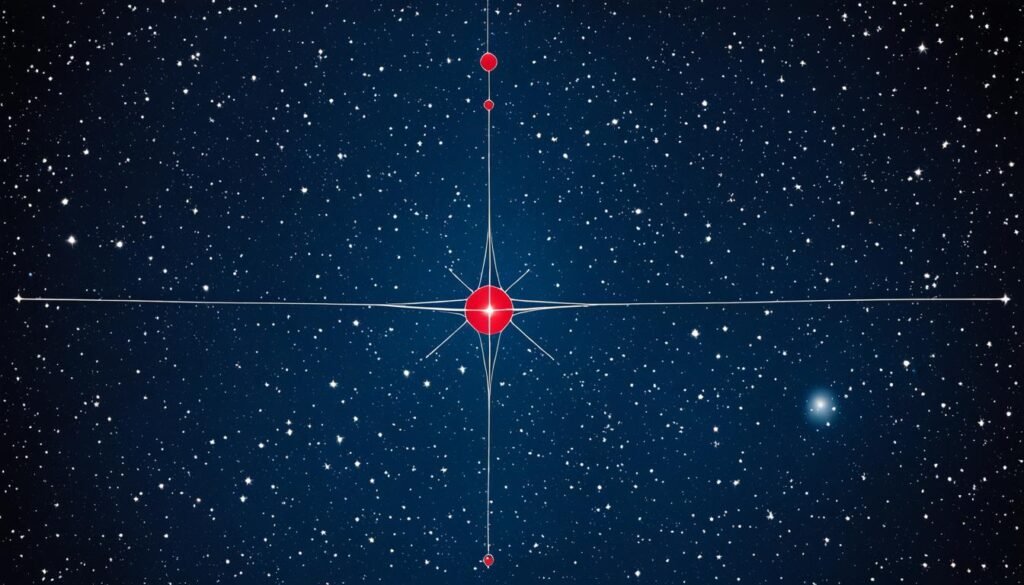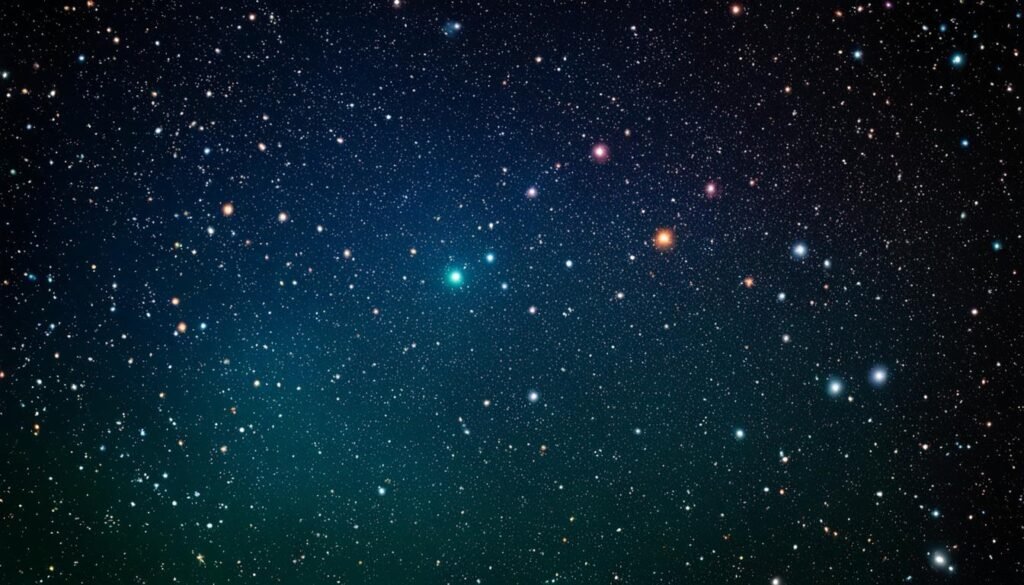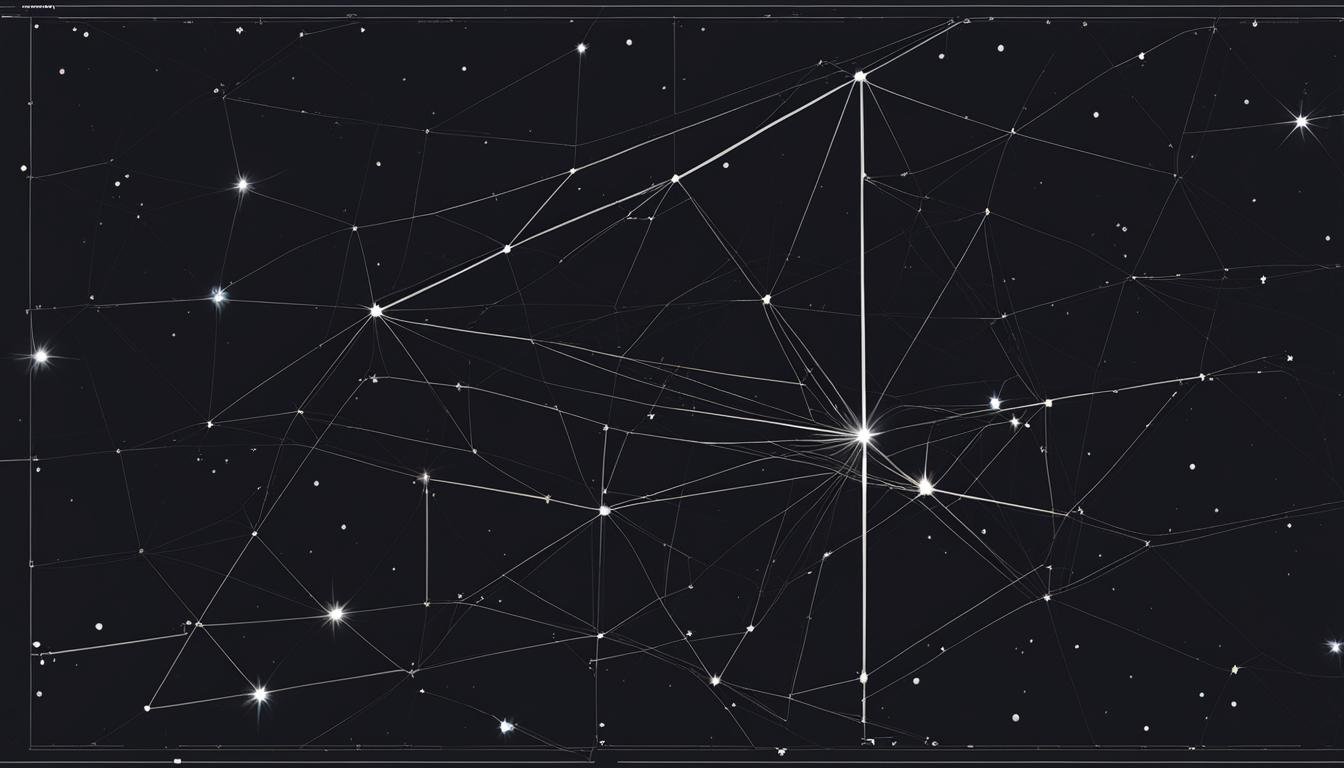| Genitive | |
| Abbreviation | |
| Pronunciation | |
| Main Stars | |
| Brightest Star | |
| Right Ascension | |
| Declination | |
| Sq. Deg. Area | |
| Crosses Meridian | |
| Visible Lat. Range |
The night sky harbors a multitude of celestial stories, among which the constellation Tucana paints its own vibrant narrative. Unknown to some, this constellation is more than a mere cluster of stars—it represents a tropical marvel nestled within the cosmos. As a stargazer or an astronomy enthusiast, your exploration of the southern heavens is incomplete without delving into the Tucana constellation facts.
Conceived by the imagination of Dutch astronomer Petrus Plancius and immortalized in the charts by Johann Bayer in the 17th century, Tucana brings together history and beauty in a tapestry of starlit wonders. While you gaze up from the Earth, the constellation’s array of celestial bodies, from the Tucana Dwarf galaxy to the Small Magellanic Cloud, beckons with stories waiting to be discovered. This guide enriches your knowledge with comprehensive Tucana constellation information, ensuring you’ll view the southern stars through informed and appreciative eyes.
Key Takeaways
- Discover the captivating story behind the constellation Tucana’s origin and its place in celestial cartography.
- Unveil the myriad of astronomical phenomena residing within Tucana, including galaxies, stars, and star clusters.
- Learn how to navigate the night sky to locate this southern constellation and its prominent features.
- Delve into the extraordinary depths of Tucana’s deep sky objects and the universe’s profound mysteries they hold.
- Explore the frontiers of modern astronomy by examining Tucana’s contributions to the ongoing search for exoplanets.
Unveiling the History of Constellation Tucana
As you delve into the rich tapestry of the night sky, the Tucana constellation history unfolds a narrative set against the vast southern hemisphere. It is a history penned by the observations of explorers and astronomers, encapsulated in the very stars that comprise this celestial marvel.
Origins in the Southern Skies
The story of the Tucana star constellation begins on a celestial globe by Petrus Plancius. It was sketched into existence based on the meticulous observations of navigators who charted the unknown southern stars. Plancius’s work served as a prelude to Johann Bayer’s famed Uranometria, an atlas that would engrave Tucana’s position among the constellations.
The Legacy of Dutch Astronomers
The role of the Dutch in charting the stars cannot be overstated. It was Plancius who first named this constellation in 1598, a legacy honored and preserved by Bayer in his atlas. The constellation, though first reflecting different avian representations, solidified its identity in astronomy due to the impactful contributions of these pioneers.
Cultural Impact and Name Evolution
The history of constellation Tucana’s naming is as captivating as its stars. From Frederick de Houtman’s initial moniker, which alluded to a hornbill, to the eventual and now well-established name ‘Tucana,’ the constellation’s identity has evolved. However, unlike many other constellations that are steeped in myths, Tucana’s significance lies in its representation of the toucan, a bird noted for its distinctively large bill. This curiosity has cemented its place not only in the cosmos but in the minds of those who gaze upon the stars, seeking knowledge and wonder.
Exploring the Tucana constellation wiki, you’ll find a table articulating the notable features of Tucana’s history:
| Feature | Description | Significance |
|---|---|---|
| Discovery | First sketched by Plancius | Laid the groundwork for southern star charts |
| Uranometria Inclusion | Named and depicted by Bayer | Promoted widespread recognition in astronomy |
| Naming Evolution | Houtman’s initial name alongside Plancius’s | Illustrates its cultural assimilation into astronomy |
| Mythological Association | None | Standout as a constellation named for its avian resemblance rather than myth |
In conclusion, the Tucana constellation embodies a history as entrancing as the patterns of stars that tell its tale. It’s a celestial chapter book written in the night sky, welcoming all to discover and cherish its enduring legacy.
Stellar Landmarks: Tucana Constellation Stars
The Tucana constellation, a tapestry woven with stellar magnificence, boasts a collection of stars that exemplify the grandeur of the cosmos. Each one contributes to the narrative of our universe in its own unique way. In the midst of these celestial treasures are the primary luminary beacons such as Alpha Tucanae, Gamma Tucanae, Kappa Tucanae, and Nu Tucanae. Let’s delve into the characteristics that make these stars stand out in the constellation Tucana. Illuminate your understanding of these astronomical wonders with the knowledge provided.
Dazzling Alpha Tucanae: A Spectroscopic Binary
Alpha Tucanae, esteemed as the brightest member of the Tucana constellation stars, remains an enigmatic spectroscopic binary system approximately 200 light-years from Earth. It shines with a magnitude of 2.86, graced by the presence of an expansive orange giant. You’ll discern its significant brightness that plays a pivotal role in the framework of Tucana’s celestial pattern.
Gamma Tucanae: The Yellow-White Giant
Behold Gamma Tucanae, a yellow-white giant star, located 75.3 light-years away, with an apparent magnitude of 3.99. It’s a colossal entity, boasting greater mass in comparison to our own Sun. The radiance of Gamma Tucanae is a beacon within the constellation, guiding your gaze through the southern skies.
Exploring the Kappa Tucanae Multiple Star System
The Kappa Tucanae system adds a layer of complexity to the Tucana constellation stars. It consists of two binary pairs separated by a mere 5.3 arc minutes. Situated roughly 66.6 light-years from our vantage point, the system provides an intriguing study into stellar relationships and cosmic interactions.
Nu Tucanae: The Pulsating Red Giant
The story of Tucana’s stars would not be complete without mentioning Nu Tucanae, a pulsating red giant with an average apparent magnitude of 4.91. Nestled 273 light-years away, this variable star offers a testament to the dynamism and transformative energy of stellar evolution within the constellation’s embrace.
As your eyes wander across the night sky, remember each of these stars is more than just a point of light – they are suns within Tucana, each with their own secrets and untold stories, ready for you to uncover. Here’s a comparative look at the key parameters of these luminous landmarks:
| Star | Designation | Type | Distance (light-years) | Apparent Magnitude |
|---|---|---|---|---|
| Alpha Tucanae | Spectroscopic Binary | Orange Giant | 200 | 2.86 |
| Gamma Tucanae | Single Star | Yellow-White Giant | 75.3 | 3.99 |
| Kappa Tucanae | Multiple Star System | Main Sequence | 66.6 | Varies |
| Nu Tucanae | Single Star | Red Giant | 273 | 4.91 |
In the grand course of cosmic observation, these Tucana constellation stars serve as milestones in the celestial expanse, captivating the minds and imaginations of astronomers and stargazers alike. The splendor of Tucana is not merely in the sum of its parts, but in the detailed stitching of galaxies, stars, and stories that it comprises. When you gaze into the night sky, let the light of Alpha Tucanae, Gamma Tucanae, Kappa Tucanae, and Nu Tucanae be your guides through the wonders of the universe.
Navigating the Constellation Tucana in the Night Sky
If you’re eager to discover the Tucana constellation in the night sky, you’re in for an astronomical treat. This beautiful constellation is an awe-inspiring sight in the vast universe. Before we delve into our stargazing journey, let’s align your expectations: Tucana is best viewed from the southern hemisphere. In fact, it does not rise above 13 degrees north latitude, making some of its parts elusive to stargazers in the northern hemisphere.
Begin your adventure by consulting a detailed Tucana constellation map. This map is not just a guiding tool; it’s a portal into the cosmos, showing Tucana’s vibrant presence in the first quadrant of the southern hemisphere (SQ1). You’ll spot Tucana by locating it in the sky south-south-west of the celestial equator, an imaginary line that mirrors Earth’s equator, projected onto the celestial sphere.
Use prominent stars such as Achernar in the constellation Eridanus as reference points. From Achernar, trace your gaze towards the south-south-west region of the heavens, and there you’ll find Tucana. It lies between the latitudes +25° and -90°, inserting itself among the backdrop’s celestial landmarks.
Now, when is the ideal time to observe? Tucana’s location means it’s visible during the late winter months in the northern hemisphere, but remember, being predominantly a southern constellation, it shines its brightest from locations below the equator.

As you familiarize yourself with the constellation Tucana, take the time to immerse in the tales it tells, from its discovery to the secrets it still holds. Whether you’re a seasoned astronomer or a passionate novice, mapping Tucana’s position in our celestial theater can be a transcendent experience, connecting you with the intrepid explorers who first charted these stars.
Lastly, it bears mentioning that while the night sky may seem unchanging, it is anything but. The stars and constellations we see are in a constant state of motion due to the Earth’s rotation and orbit around the Sun. Thus, the precise location of constellation Tucana may vary slightly depending on the time of the year. So grab your telescope, clear your schedule for an evening, and prepare for a celestial rendezvous with the splendid Tucana constellation.
Deep Sky Delights: Exploring Tucana’s Celestial Objects
As you gaze upon the southern heavens, the Tucana constellation deep sky objects beckon with their ancient light and celestial splendor. Embedded within this celestial expanse are several astronomical wonders, including the elusive Tucana Dwarf, the vast Small Magellanic Cloud, and the resplendent globular cluster known as 47 Tucanae.

Tucana Dwarf: A Lonely Spheroidal Galaxy
Isolated and understated, the Tucana Dwarf is a spheroidal galaxy that evades the unaided eye. At a magnitude of 15.7, it lies approximately 3.2 million light-years from Earth. This celestial antiquity is composed of stars that are relics of times long past, offering a ghostly window into the early universe with its lack of new star formation.
The Small Magellanic Cloud’s Captivating Glow
Neighboring its inconspicuous companion, the Small Magellanic Cloud (SMC) presents a sprawling spectacle spanning 7 degrees across the celestial sphere, shining at a relatively bright magnitude of 2.7. This dwarf galaxy, approximately 197,000 light-years away, is awash with clusters, nebulae, and ongoing stellar creation, marking it as a hotbed of astronomical study and observation.
The Splendor of Globular Cluster 47 Tucanae
Charting back to your telescope’s eyepiece, the jaw-dropping grandeur of 47 Tucanae awaits. One of the night sky’s most luminous and closest globular clusters, it dazzles observers at a magnitude of 4.0 from about 16,700 light-years away. With hundreds of thousands of stars clustering in a spherical formation, 47 Tucanae offers a magnificent view that is a testament to the complexity of the Milky Way.
Modern Astronomy and Tucana’s Exoplanets
As we delve further into the cosmos, the constellation Tucana emerges as a pivotal arena in modern astronomy’s quest to uncover new worlds. Within this celestial framework, a number of stars have been found to play host to exoplanets, enticing astronomers and cosmic enthusiasts alike with the promise of discovering realms beyond our solar system. These distant planets not only pique our curiosity but also expand our grasp on the varied characteristics and potential habitability of extraterrestrial environments.
The Search for New Worlds: Exoplanets in Tucana
Your fascination with the endless universe gets a fresh impetus as we explore the exoplanets of Tucana. When you gaze up at the night sky, remember that Tucana’s Exoplanets stand as beacons for scientists in their endeavor to map out our galactic neighborhood. These alien worlds offer us invaluable insights, refining our understanding of planet formation, evolution, and the potential for life beyond Earth. It’s an ongoing adventure that underscores humanity’s insatiable thirst for knowledge about the cosmos.
HD 219077 and Its Gas Giant Companion
Among the notable celestial discoveries in Tucana is HD 219077, a star teeming with astral significance due to its massive planetary companion. This gas giant, with a mass that towers over Jupiter’s by at least 10.39 times, captivates the astronomical community and provides a unique laboratory for studying planetary system dynamics and composition.
HD 221287’s Distant Orbiting Planet
Not to be outdone, HD 221287 also claims its stake in the exoplanet annals with a significant find: a planet possessing at least 3.12 times the mass of Jupiter. Freckled across the cosmic canvas, these discoveries invite you to contemplate the diversity of planetary systems and the intricate dance of celestial bodies that defines our universe. Tucana’s Exoplanets like those orbiting HD 219077 and HD 221287 serve as vital puzzle pieces in the grand cosmic mosaic, encouraging us to keep our eyes to the skies in anticipation of the next revolutionary discovery.
FAQ
What are some key facts about the Tucana constellation?
The Tucana constellation is a celestial pattern in the southern sky representing the exotic bird, the toucan. It was introduced by Dutch astronomer Petrus Plancius in the late 16th century, and covers 295 square degrees of the sky. The constellation is situated in the SQ1 quadrant and is best viewed from the southern hemisphere.
Who discovered the Tucana constellation and when?
The Tucana constellation was first discovered and named by the Dutch astronomer Petrus Plancius around 1598, based on observations by sailors Frederick de Houtman and Pieter Dirkszoon Keyser. It was later charted in Johann Bayer’s Uranometria in 1603.
What is the history and cultural significance of the Tucana constellation?
The Tucana constellation does not have associated myths but is named after the South American bird, the toucan, due to its large, prominent bill. It is part of a family of constellations introduced by Dutch navigators and astronomers after their navigational discoveries.
Which are the brightest stars in the Tucana constellation?
Alpha Tucanae is the constellation’s brightest star, followed by notable others such as Gamma Tucanae, a yellow-white giant, and the complex Kappa Tucanae multiple star system. Nu Tucanae, a red variable star, is also significant in this star pattern.
Where and how can I locate the Tucana constellation?
The Tucana constellation is located in the southern sky and can best be viewed from the southern hemisphere, particularly between latitudes +25° and -90°. Look south-south-west from the celestial equator, using reference stars from neighboring constellations to help pinpoint Tucana’s location.
What deep sky objects are found in the Tucana constellation?
Among Tucana’s deep sky objects are the Tucana Dwarf galaxy, an ancient spheroidal galaxy, and the Small Magellanic Cloud, which is easily observable with the naked eye. Additionally, the globular cluster 47 Tucanae is also a bright and closely situated object in this constellation.
Has the search for exoplanets included the Tucana constellation?
Yes, several exoplanets have been found in the Tucana constellation, illuminating the constellation’s significance in modern astronomy. Notable among these are the planets orbiting stars like HD 219077, known for its gas giant companion, and HD 221287, along with other exoplanets that have been discovered in Tucana.
What is the best time of year to observe the Tucana constellation?
The Tucana constellation is best viewed in late Southern Hemisphere winter to early summer, roughly from August to December, when it is highest in the sky for observers located in the southern parts of the world.
Is there any mythological significance attached to the Tucana constellation?
Unlike many other constellations, Tucana doesn’t bear any mythological significance. Instead, it is one of the constellations named for its resemblance to a creature, in this case, a toucan, by Dutch explorers and navigators during their voyages.
Can Tucana be seen from northern latitudes?
The Tucana constellation is not visible from most northern latitudes; it is a southern constellation best observed from locations south of the equator. However, it can be partially seen near the equator or in extreme southern areas of the Northern Hemisphere at very low elevations.






